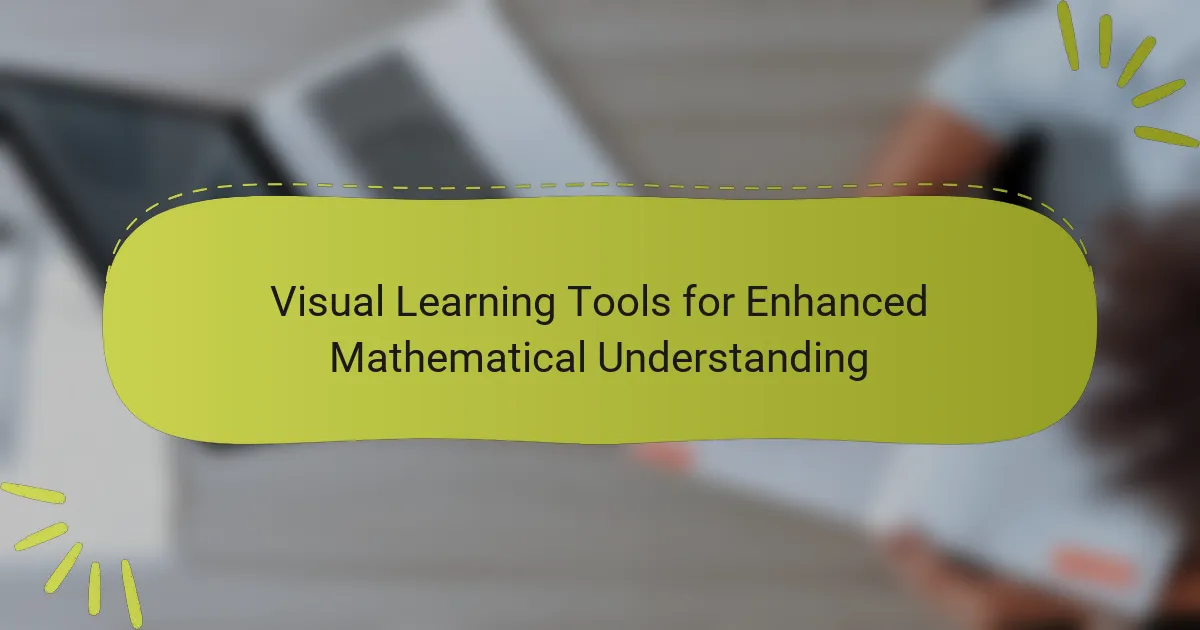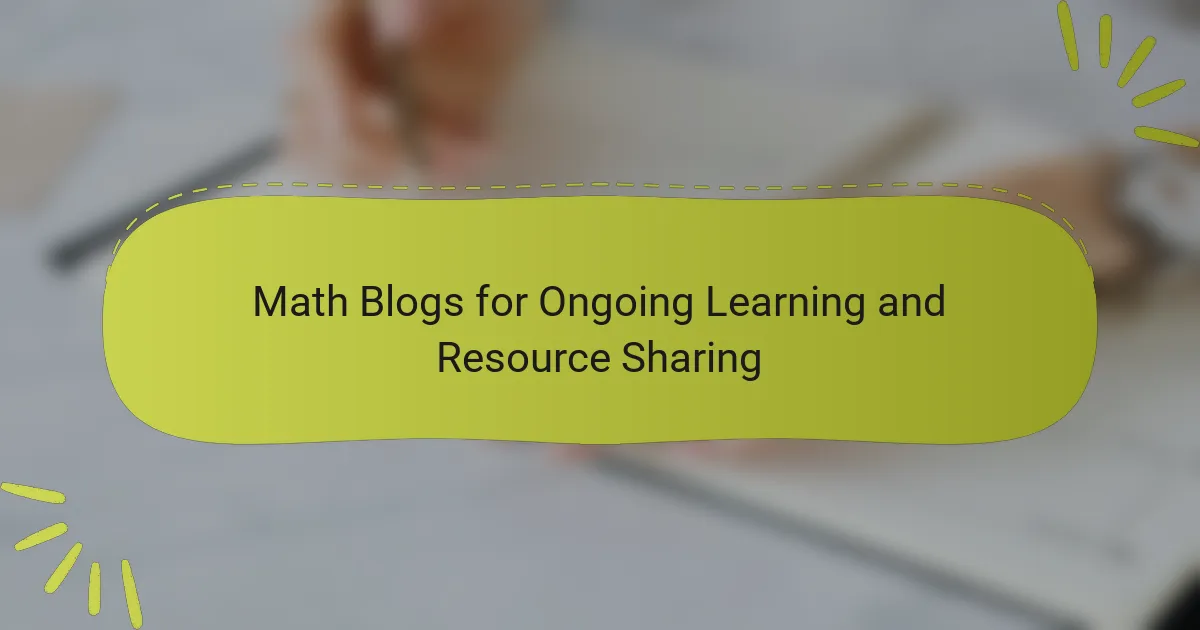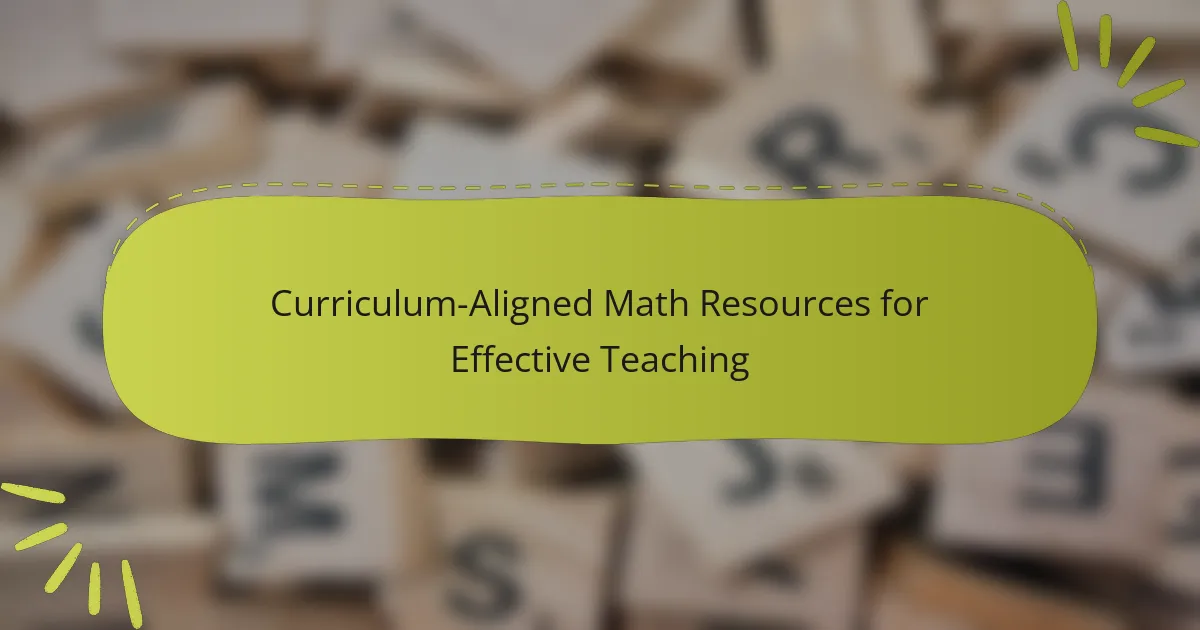Math manipulatives are physical objects used in education to teach mathematical concepts through hands-on exploration. These tools, which include blocks, counters, and shapes, enable learners to visualize and manipulate abstract mathematical ideas, thereby enhancing engagement and problem-solving skills. Research indicates that effective math manipulatives should be tactile, versatile, visually appealing, and suitable for collaborative learning among students. The article outlines strategies for integrating math manipulatives into lessons, emphasizing the importance of clear objectives, guided exploration, and reflective assessment to maximize their educational impact.

What are Math Manipulatives for Hands-On Learning and Exploration?
Math manipulatives are physical objects used to teach mathematical concepts through hands-on exploration. They include items like blocks, counters, and shapes that allow learners to visualize and manipulate mathematical ideas. These tools help students understand abstract concepts by providing tangible representations. Research shows that using manipulatives enhances engagement and improves problem-solving skills. For example, a study by Clements and Sarama found that children who used manipulatives performed better in mathematics compared to those who did not. Therefore, math manipulatives are essential for effective hands-on learning and exploration in mathematics education.
How do Math Manipulatives enhance learning experiences?
Math manipulatives enhance learning experiences by providing tactile and visual tools for understanding mathematical concepts. They facilitate active engagement and allow learners to explore abstract ideas in a concrete manner. Research shows that students using manipulatives perform better in problem-solving tasks. For example, a study by Moyer, Jones, and Thornton (2004) found that manipulatives improve students’ conceptual understanding and retention of math skills. They also cater to diverse learning styles, making math accessible to all students. By enabling hands-on exploration, manipulatives foster a deeper connection to mathematical principles.
What types of Math Manipulatives are commonly used in classrooms?
Common types of math manipulatives used in classrooms include base ten blocks, counters, and number lines. Base ten blocks help students understand place value and operations. Counters assist in teaching addition, subtraction, and basic multiplication. Number lines support concepts of ordering, addition, and subtraction. Other manipulatives are pattern blocks, which aid in geometry and fractions, and unifix cubes for hands-on counting and grouping. These tools enhance student engagement and comprehension in mathematical concepts.
How do different Math Manipulatives cater to various learning styles?
Different math manipulatives cater to various learning styles by providing tactile, visual, and auditory experiences. For kinesthetic learners, manipulatives like blocks or counters allow hands-on interaction. Visual learners benefit from tools such as number lines or charts that represent abstract concepts visually. Auditory learners engage through discussions about the manipulatives, reinforcing understanding through verbal explanations. Research shows that using manipulatives can improve student engagement and comprehension. A study by Clements and Sarama (2009) found that children using manipulatives demonstrated better problem-solving skills compared to those who did not. This evidence supports the effectiveness of manipulatives in addressing diverse learning preferences.
Why are Math Manipulatives important in education?
Math manipulatives are important in education because they enhance understanding of mathematical concepts. They provide a tactile way for students to explore abstract ideas. Research shows that hands-on learning improves retention and engagement. For example, studies indicate that students using manipulatives score higher on assessments. Manipulatives also cater to diverse learning styles, making math accessible to all students. They help bridge the gap between concrete and abstract thinking. Overall, math manipulatives foster a deeper comprehension of mathematics.
What cognitive benefits do Math Manipulatives provide to students?
Math manipulatives enhance cognitive skills in students by providing hands-on experiences that facilitate understanding of abstract concepts. They promote active learning, which leads to better retention of mathematical ideas. Research shows that manipulatives improve problem-solving skills and critical thinking. For example, a study by Clements and Sarama (2009) found that students using manipulatives scored higher on assessments than those who did not. This indicates that manipulatives can bridge the gap between concrete and abstract reasoning. Additionally, they foster engagement and motivation, which are essential for cognitive development. Overall, math manipulatives serve as effective tools for enhancing cognitive benefits in students.
How do Math Manipulatives support problem-solving skills?
Math manipulatives support problem-solving skills by providing concrete representations of abstract concepts. They allow learners to visualize mathematical problems, making it easier to understand relationships and operations. For example, using blocks to represent numbers helps students grasp addition and subtraction more intuitively. Research shows that students who engage with manipulatives demonstrate improved problem-solving abilities. A study by Clements and Sarama (2009) found that children using manipulatives performed better in mathematics compared to those who did not. This hands-on approach fosters critical thinking and encourages exploration of various problem-solving strategies. Ultimately, math manipulatives enhance students’ confidence and competence in tackling mathematical challenges.
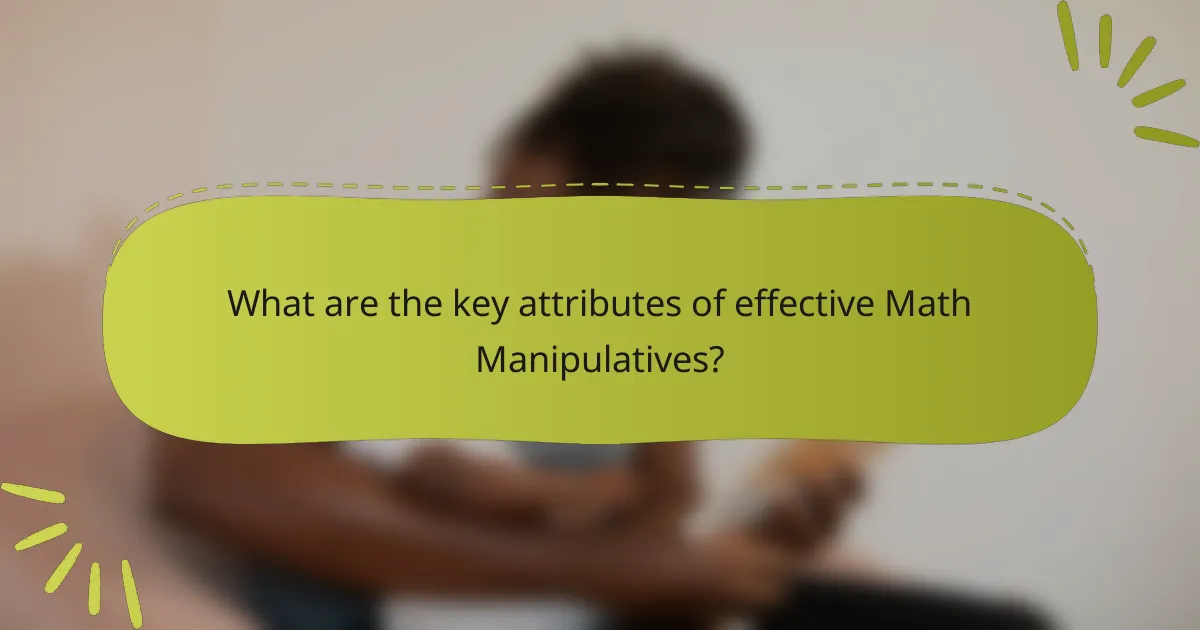
What are the key attributes of effective Math Manipulatives?
Effective Math Manipulatives possess several key attributes. They should be tactile and engaging, allowing students to physically interact with mathematical concepts. This hands-on approach enhances understanding and retention of skills. Additionally, manipulatives should be versatile, applicable across various mathematical topics. They must also be visually appealing to capture students’ interest. Furthermore, effective manipulatives promote collaborative learning, encouraging group activities. Finally, they should be age-appropriate, catering to the developmental stages of learners. Research indicates that manipulatives improve problem-solving skills and conceptual understanding in mathematics.
How can educators select the right Math Manipulatives for their students?
Educators can select the right math manipulatives by assessing their students’ learning needs. Understanding the specific mathematical concepts being taught is crucial. Different manipulatives serve different purposes, such as counting, measuring, or spatial reasoning. For example, base-ten blocks are effective for teaching place value. Additionally, educators should consider the age and developmental stage of their students. Younger students may benefit from colorful, tactile objects. In contrast, older students might require more abstract tools like algebra tiles. Research indicates that hands-on manipulatives enhance student engagement and understanding. A study by Clements and Sarama (2009) found that using manipulatives improves mathematical learning outcomes. Thus, selecting manipulatives that align with educational goals and student needs is essential.
What criteria should be considered when choosing Math Manipulatives?
When choosing math manipulatives, consider their educational value. They should align with learning objectives and enhance understanding of mathematical concepts. Evaluate the manipulatives for durability and safety, ensuring they can withstand frequent use. Assess the manipulatives’ versatility; they should support various mathematical topics. Check for ease of use, as manipulatives should be user-friendly for both students and teachers. Consider the manipulatives’ ability to engage students, fostering interest in math. Lastly, ensure they are accessible and inclusive for all learners, accommodating diverse needs.
How do age and developmental stage influence the selection of Math Manipulatives?
Age and developmental stage significantly influence the selection of math manipulatives. Younger children benefit from concrete, tactile manipulatives such as blocks and counters. These tools support their developing fine motor skills and understanding of basic concepts. As children grow, they require more abstract manipulatives like number lines and algebra tiles. These support higher-level thinking and problem-solving skills. Research shows that manipulatives aligned with developmental stages enhance engagement and comprehension. For example, the National Council of Teachers of Mathematics emphasizes the importance of using age-appropriate tools for effective learning. Thus, selecting manipulatives that match age and developmental needs is crucial for fostering mathematical understanding.
What role do Math Manipulatives play in different mathematical concepts?
Math manipulatives play a crucial role in enhancing understanding of various mathematical concepts. They provide tangible objects that help learners visualize abstract ideas. For instance, blocks can demonstrate addition and subtraction by physically combining or separating them. Similarly, fraction tiles allow students to see and compare fractions more effectively. Research indicates that using manipulatives can improve student engagement and retention of mathematical principles. A study by Clements and Sarama (2009) found that children who used manipulatives scored higher on assessments than those who did not. Therefore, math manipulatives serve as essential tools for facilitating hands-on learning and exploration in mathematics.
How do Math Manipulatives aid in teaching basic arithmetic operations?
Math manipulatives aid in teaching basic arithmetic operations by providing tangible, hands-on tools for students. These tools help visualize abstract concepts like addition and subtraction. For example, using blocks or counters allows learners to physically group and separate quantities. This concrete representation enhances understanding and retention of mathematical principles. Research shows that students who use manipulatives perform better on arithmetic tasks. A study by Clements and Sarama (2009) found that manipulatives significantly improve students’ mathematical reasoning. This evidence supports the effectiveness of manipulatives in fostering arithmetic skills.
In what ways do Math Manipulatives help in understanding geometry?
Math manipulatives enhance understanding of geometry by providing tactile experiences. They allow students to visualize geometric concepts. This hands-on approach aids in grasping shapes, angles, and spatial relationships. For instance, using geometric solids helps learners understand volume and surface area. Manipulatives also facilitate exploration of transformations like rotation and reflection. Research indicates that students using manipulatives show improved problem-solving skills. A study by Clements and Sarama (2009) found that manipulatives significantly boost spatial reasoning in young learners. Thus, math manipulatives are effective tools for deepening geometric comprehension.
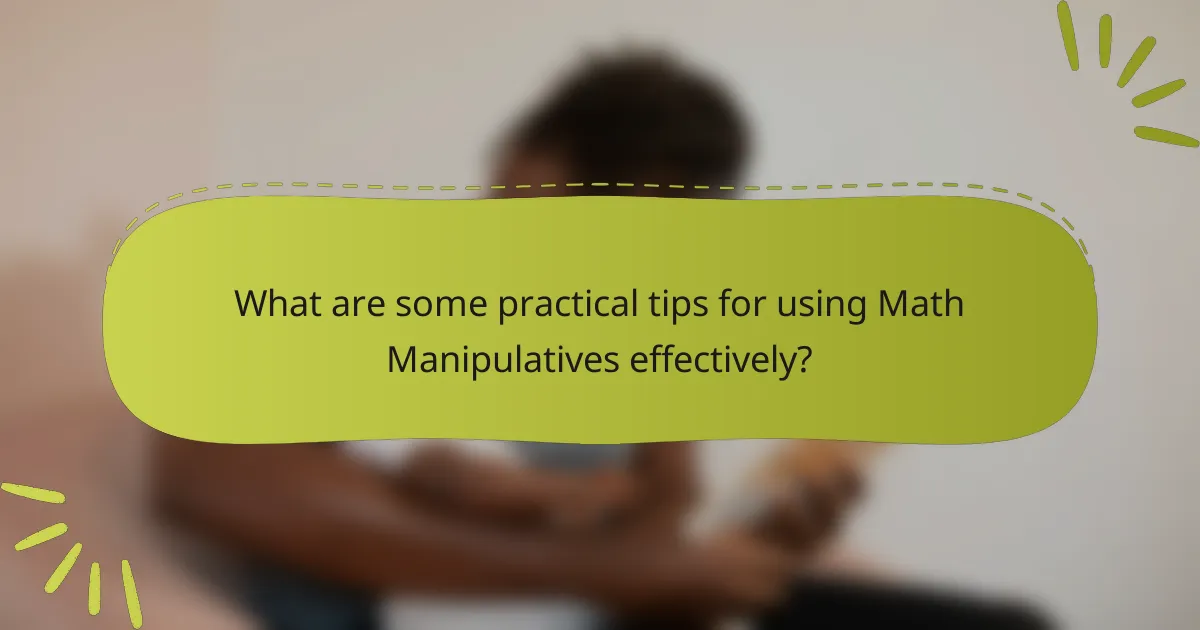
What are some practical tips for using Math Manipulatives effectively?
Use math manipulatives by integrating them into lessons. Start with clear objectives for each activity. Choose manipulatives that align with the learning goals. Demonstrate how to use them before student engagement. Encourage collaborative exploration among students. Provide guided questions to facilitate critical thinking. Assess understanding through observation during activities. Lastly, reflect on the effectiveness of the manipulatives after the lesson.
How can teachers integrate Math Manipulatives into their lesson plans?
Teachers can integrate math manipulatives into their lesson plans by incorporating hands-on activities. They can use items like blocks, counters, or number lines to illustrate mathematical concepts. For example, teachers can demonstrate addition and subtraction using physical counters. This method allows students to visualize problems, enhancing understanding. Research shows that manipulatives improve student engagement and retention of concepts. A study by Clements and Sarama (2009) found that using manipulatives significantly boosts learning outcomes in early mathematics. Teachers should also encourage collaborative group work with manipulatives to foster discussion and peer learning.
What strategies can enhance student engagement with Math Manipulatives?
Incorporating interactive activities enhances student engagement with math manipulatives. Using real-world applications makes math relevant and interesting. Group work encourages collaboration and discussion among students. Providing choices allows students to select manipulatives that resonate with them. Incorporating technology, such as digital manipulatives, can attract tech-savvy learners. Offering challenges or games increases motivation and enjoyment in learning. Regularly rotating manipulatives keeps the learning environment fresh and stimulating. Research indicates that hands-on activities improve understanding and retention of mathematical concepts.
How can assessment be effectively conducted with Math Manipulatives?
Assessment with math manipulatives can be effectively conducted through observation and structured tasks. Teachers can observe students as they interact with manipulatives to gauge understanding. Structured tasks can involve specific problems requiring the use of manipulatives for solutions. This method allows for real-time assessment of skills and concepts.
For example, students can demonstrate their understanding of addition by using counters. Teachers can assess their ability to group and combine these counters. Additionally, using exit tickets after hands-on activities provides immediate feedback. This feedback can inform future instructional decisions. Research shows that manipulatives enhance student engagement and learning outcomes.
Math manipulatives are physical objects utilized in education to teach mathematical concepts through hands-on exploration. This article explores the significance of math manipulatives, detailing their types, cognitive benefits, and their role in enhancing problem-solving skills. It discusses how manipulatives cater to diverse learning styles and the criteria educators should consider when selecting them. Additionally, the article provides practical tips for effective use of manipulatives in lesson plans and assessment strategies to improve student engagement and understanding in mathematics.
